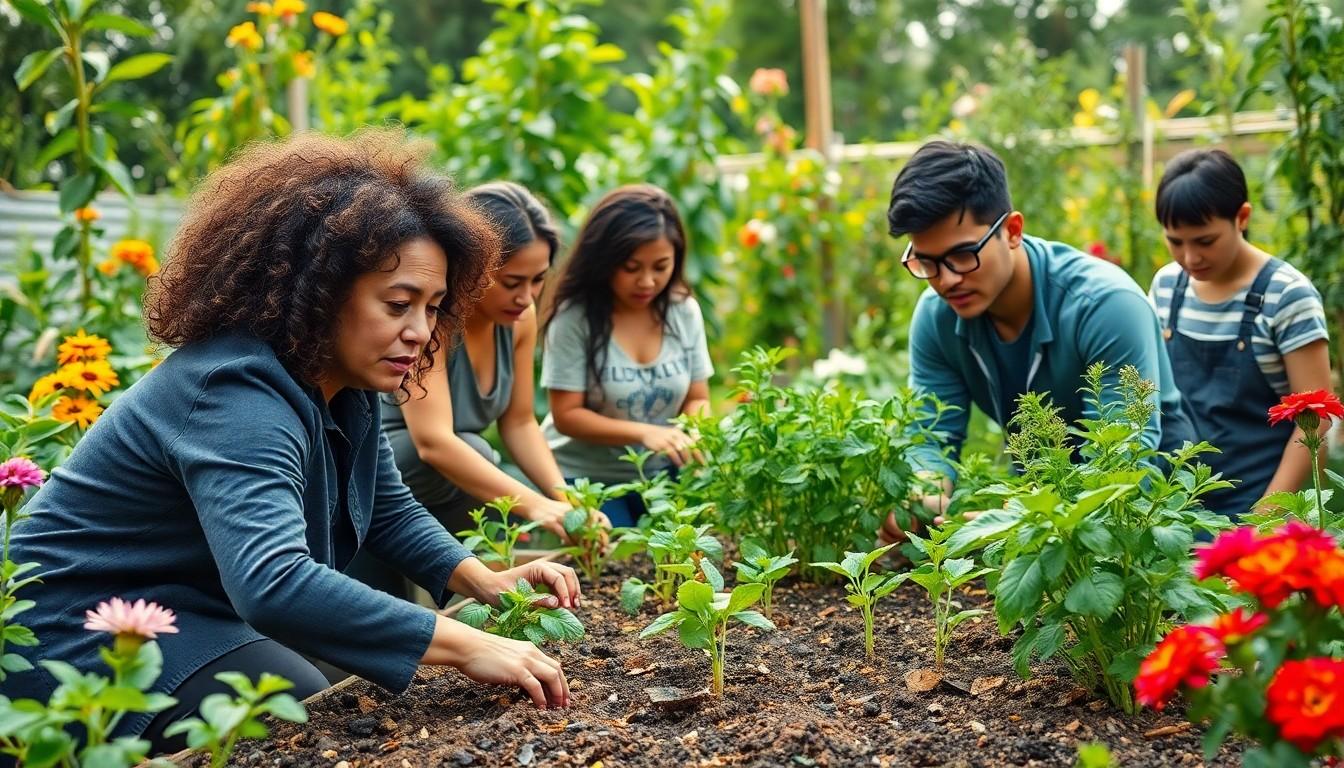In a world where plastic bags seem to multiply like rabbits and the weather’s more unpredictable than a cat on a hot tin roof, sustainable living has never been more crucial. Imagine a life where your morning coffee doesn’t come with a side of guilt, and your garden thrives without a chemical cocktail. Welcome to the ecosystem for sustainable living, where harmony with nature isn’t just a dream—it’s a lifestyle choice that’s as trendy as avocado toast.
Ecosystem for Sustainable Living
Sustainable living thrives on a balanced ecosystem that supports human needs while protecting the environment. It emphasizes a lifestyle that respects natural resources.
Definition and Importance
An ecosystem for sustainable living encompasses the relationship between living organisms and their environments. This interdependence creates a system that promotes biodiversity, reducing pollution and conserving resources. Sustainable practices lead to healthier communities, ensuring future generations thrive. The significance of understanding this relationship lies in addressing climate change, resource depletion, and habitat destruction. Knowing the importance of ecological balance helps individuals make informed choices.
Key Components
Several key components contribute to a resilient ecosystem. Biodiversity serves as a foundation, promoting various species to coexist and support each other. Renewable energy sources, such as solar and wind power, play a crucial role in reducing carbon footprints. Water conservation practices, including rainwater harvesting, enhance resource efficiency. Sustainable agriculture practices, like organic farming, maintain soil health and reduce chemical usage. Efforts to implement these components lead to healthier lifestyles and a cleaner planet.
Benefits of Sustainable Ecosystems

Sustainable ecosystems provide numerous advantages that enhance both the environment and the economy. Recognizing these benefits fosters a deeper commitment to sustainable living practices.
Environmental Impact
Sustainable ecosystems significantly reduce pollution levels. Improved air quality results from reduced emissions and chemical usage. Biodiversity thrives, which strengthens ecosystem resilience. Natural habitats support various organisms, maintaining ecological balance. Water conservation practices minimize waste and protect local waterways. Moreover, sustainable agriculture practices enrich the soil, promoting healthier crop production.
Economic Advantages
Economic benefits emerge from sustainable ecosystems as well. Reduced costs occur through energy efficiency measures. Jobs in the renewable energy sector often increase, driven by growing demand for green technology. Community resilience improves, leading to decreased dependence on external resources. Local businesses thrive when consumers prioritize sustainably sourced products. Investments in green infrastructure yield long-term savings for municipalities and individuals alike.
Strategies for Building Sustainable Ecosystems
Building sustainable ecosystems requires thoughtful strategies that foster community engagement and leverage innovative technologies. These approaches enhance resilience and promote healthier environments.
Community Involvement
Community involvement plays a crucial role in establishing sustainable ecosystems. Engaging local residents in conservation efforts encourages shared responsibility for the environment. Initiatives like neighborhood clean-ups and community gardens not only enhance local biodiversity but also strengthen social ties. When residents actively participate in environmental stewardship, they develop a deeper connection to their surroundings. Programs that educate people about sustainable practices lead to increased awareness and collective action. Participatory decision-making ensures that diverse perspectives shape sustainable initiatives, creating solutions that resonate with the community’s unique needs and values.
Innovative Technologies
Innovative technologies serve as powerful tools for building sustainable ecosystems. Smart irrigation systems optimize water usage, reducing waste through data-driven analysis. Renewable energy sources, such as solar panels and wind turbines, provide clean energy alternatives that lower carbon footprints. Advances in waste management technologies, such as composting systems and recycling innovations, divert waste from landfills and promote resource recovery. Additionally, precision agriculture employs technology to enhance crop production while minimizing environmental impact. Platforms that connect sustainable product suppliers and consumers facilitate the transition to more responsible consumption habits. By adopting these technological solutions, communities can create resilient ecosystems that thrive for generations.
Case Studies of Successful Ecosystems
Successful ecosystems demonstrate the principles of sustainable living in both urban and rural settings, illustrating diverse approaches to environmental harmony.
Urban Ecosystems
Cities like Portland, Oregon showcase effective urban ecosystems. Green building initiatives emphasize energy efficiency and sustainability. Community gardens enhance food security and promote local biodiversity. Integrated public transportation systems, such as light rail, reduce reliance on cars and lower emissions. Green roofs and living walls improve air quality while providing habitats for wildlife. These features collectively create urban environments that prioritize ecological health and support resident well-being.
Rural Ecosystems
Rural areas exemplify sustainability through practices like permaculture. In places such as Wanganui, New Zealand, farmers adopt holistic land management techniques. Crop rotation and agroforestry boost soil health and enhance biodiversity. Rainwater harvesting systems conserve water and foster resilience against drought. Livestock integrated into crop farming reduces waste while producing natural fertilizers. These strategies create fertile landscapes that align agricultural productivity with ecological balance.
Challenges to Creating Sustainable Ecosystems
Creating sustainable ecosystems faces various challenges. Addressing these hurdles is vital for achieving long-term environmental goals.
Policy and Regulation Issues
Policy gaps often hinder the progress of sustainable ecosystem development. Inconsistent regulations may conflict with local practices, limiting effective implementation. Enforcement of existing environmental laws lacks uniformity, causing confusion among community stakeholders. Many regions experience inadequate support for sustainability initiatives due to insufficient policy frameworks. Moreover, regulations may overlook emerging technologies that promote sustainability, resulting in missed opportunities for advancement. Addressing these legislative challenges leads to stronger ecosystems that benefit communities.
Social and Economic Barriers
Social acceptance is crucial for fostering sustainable ecosystems. Resistance from communities often arises when proposals conflict with established habits or lifestyles. Economic disparities also play a significant role, as low-income areas struggle to adopt new sustainable practices due to financial constraints. Limited access to resources restricts local efforts to implement eco-friendly solutions. In addition, companies may prioritize short-term profits over long-term sustainability, complicating community efforts to build lasting ecosystems. Tackling these social and economic barriers enhances environmental resilience and encourages widespread adoption of sustainable practices.
Supports Economic Growth
Embracing sustainable living is crucial for fostering a healthier planet and vibrant communities. By understanding the intricate relationships within ecosystems, individuals can make informed choices that benefit both the environment and their well-being.
The integration of biodiversity, renewable energy, and sustainable practices not only enhances ecological resilience but also supports economic growth. Communities that prioritize these principles are better equipped to face environmental challenges while enjoying the benefits of cleaner air and healthier lifestyles.
As more people engage in sustainable practices, the collective impact can lead to significant positive change. It’s a journey worth taking for a sustainable future that balances human needs with the health of our planet.

